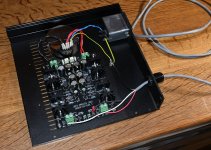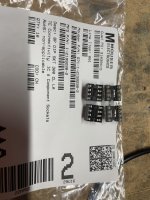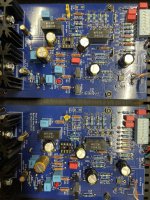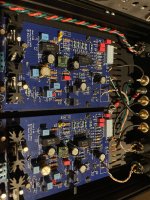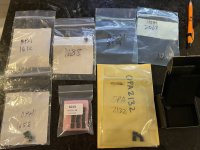Bummer !!!It’s my tinnitus!
I have tinnitus too. Mine is intermittent, and catches my attention when it stops. When it is on, I can filter it out; however, I can have difficulty identifying soft sounds - is that a bird at the feeder, or a mouse behind the baseboard, or a Brazilian percussion instrument in the music.
This all does little to curb my construction compulsions, but I won't be volunteering for Mark Johnson's OpAmp challenge.
Many MM carts work at 47k, but optimal loading can vary from 22k to 100k.
Looking at the schematic -- and please correct me if I'm missing something -- I don't see why one couldn't substitute any useful R or C values for the DIP switch. Depends what carts you're going to run and how much cart rolling you expect to do.
Nice to have this option on the board. I just had my own boards fabbed for adding adjustable loading on some other phono stage projects.
If you want to redo the DIP Loading you need to update R12 (now 47k) and resistors for DIP switch positions 1-6.
It's a matter of doing a parallel resistor calculation of whatever you put in R12 with whatever DIP positions are turned on.
The default is set for 47k and a range for MC carts. But there's nothing stopping anyone for making it set up for a range of potential values for MM carts bewteen 22-100k. It comes down to doing a bit of math (excel is helpful here...) and then swap to the desired resistors.
@Auricle
I too have tinnitus that I notice intermittently... like now... but it's always "on".
I'd hate to miss the sounds of the birds at the back deck. this past year a clutch of red-breasted nuthatches have been frequent guests. they chatter softly when I go out with seeds in my hand... almost musical murmuring. They're great fun.
I too have tinnitus that I notice intermittently... like now... but it's always "on".
I'd hate to miss the sounds of the birds at the back deck. this past year a clutch of red-breasted nuthatches have been frequent guests. they chatter softly when I go out with seeds in my hand... almost musical murmuring. They're great fun.
I spent some time "capturing" the umbilical at PSU end (3 + 1 cable).
Then I will cut down the cable to desired length when time comes. Now it is about 1.8m.
I also attached the technical data for my cartridge. The recommended load is 47k and 150 - 300 pF.
Then I guess I should also dial-in a capacitor using the dip switches.
Kit is released from customs so should get it soon.
Then I will cut down the cable to desired length when time comes. Now it is about 1.8m.
I also attached the technical data for my cartridge. The recommended load is 47k and 150 - 300 pF.
Then I guess I should also dial-in a capacitor using the dip switches.
Kit is released from customs so should get it soon.
Attachments
My understanding is that capacitance can have an effect on MM cartridges but it generally isn't a large difference. I did a quick search on vinyl engine, and there are some more in depth explanations, but one fellow said, "Doesn't seem anyone's actually addressed the latter part of the OP's question, so I'll have a go. Too much capacitance can roll off the high end in unintended ways. That said, it's more of a problem with carts that specifically call for low capacitance throughout; generally you won't find it overly critical. As said, let your ears be your guide."I also attached the technical data for my cartridge. The recommended load is 47k and 150 - 300 pF.
The sockets I had on my boards are good for standard op amps, but not for the SOIC adapters I made. So just swapped out sockets. Time to op amp roll. Mouser p/n is on the bag in the pic.
Opa1612 is the first to try.
Opa1612 is the first to try.
Attachments
Last edited:
I've got an older Ortofon VME15 XE that sounds kinda thin in the bass with my current 47K loaded phono preamp. I also have a vintate SURE RXT5 that I plan to replace with a new Grado Prestige Gold 3 when I get time. I was told some catridges like about 10k loading... Somewhere I had some formulas for calculating the ideal loading based on the cartridge's inductance, resistance, and turntable cable capacitance. I'll have to find that info. The remapping could get very interesting - the possibilities are almost endless. I'm thinking I'll build stock when I get a kit, and experiment with the existing loadings. My cables already have about 100pf so it will be easy to adjust that.
Post #881 has an interview with Wayne and a FAQ section that (amongst a whole lot of other things) covers loading… https://www.diyaudio.com/community/threads/pearl-3-burning-amp-2023.404054/post-7526056
The Cliff’S Notes version is “feel free to change loading resistors or capacitors to anything you want”
🙂 🙂
The Cliff’S Notes version is “feel free to change loading resistors or capacitors to anything you want”
🙂 🙂
What Power Entry Module and front panel switch are folks with Gianluca's case using?
I saw Schurter DD12.9111.111 filtered and DD11.0111.1111 non-filtered PEM's were recommended in post #737 but can't find info on the correct switch that will fit the case cut out.
Would filtered PEM be beneficial in this application or is non-filtered OK?
Thanks.
I saw Schurter DD12.9111.111 filtered and DD11.0111.1111 non-filtered PEM's were recommended in post #737 but can't find info on the correct switch that will fit the case cut out.
Would filtered PEM be beneficial in this application or is non-filtered OK?
Thanks.
Filtered is always beneficial, in my opinion.
Would I use one without? Of course! But a filtered IEC is a good place to spend the additional money.
The front panel switch is just a 1/4” panel mount toggle.
Build Document, found in post #1 has BOM for all this.
Would I use one without? Of course! But a filtered IEC is a good place to spend the additional money.
The front panel switch is just a 1/4” panel mount toggle.
Build Document, found in post #1 has BOM for all this.
@mhenschel If things sound funny at the bird feeder, it might not be your tinnitus......miss the sounds of the birds at the back deck...
I have a Lyra Clavis cartridge that a friend gave to me, because it sounded so bright and thin. I tried it thru a Rothwell MCX and had the same results, unlistenable. Looking up the specs I see that it has an internal impedance of 2 ohms, is this likely to cause what I heard?
General recommendations for settings on the P3?
General recommendations for settings on the P3?
See the cartridge loading table / dip switch settings in the build guide. Start at the lowest settings and work your way up to get the sound you prefer in your system.
General wisdom that for MC's the correct resistive loading is 10-20 x (moving coil cartridge coil impedance).
General wisdom that for MC's the correct resistive loading is 10-20 x (moving coil cartridge coil impedance).
That would be about 100 ohms, isn't that what the Rothwell is? This cartridge had gotten wonderful reviews in the pay to play mags, so I'm wondering if that's the way they sound, it needs different settings or is defective.General wisdom that for MC's the correct resistive loading is 10-20 x (moving coil cartridge coil impedance).
The Rothwell is 10X transformer, so I would expect the resistance looking into the primary to be 1/(10^2) times the phono stage input resistance. If that is the usual 47K, then 470 ohms. I wonder if Rothwell has some internal resistors.100 ohms, isn't that what the Rothwell is?
It would be interesting to Quasimodo the transformer. However, I have read warnings that such transformers can become magnetized by applying DC, even by trying to measure the resistance with a meter. Worry first, measure second.
For anyone who doesn't want to bother/struggles with soldering SMD components, Aion FX has pre-soldered, adapter mounted JFETs: https://aionfx.com/component/2sk209-gr-jfet/
They also sell the panelized adapters (https://aionfx.com/project/jfet-adapter/) if you want to try different components or something. Not saying this is the best thing to do, but it's an option you may not be aware of. I used these adapters when first learning to solder SMD JFETs so if I made a mistake, it wasn't on the main board.
They also sell the panelized adapters (https://aionfx.com/project/jfet-adapter/) if you want to try different components or something. Not saying this is the best thing to do, but it's an option you may not be aware of. I used these adapters when first learning to solder SMD JFETs so if I made a mistake, it wasn't on the main board.
- Home
- Amplifiers
- Pass Labs
- Pearl 3 Burning Amp 2023
